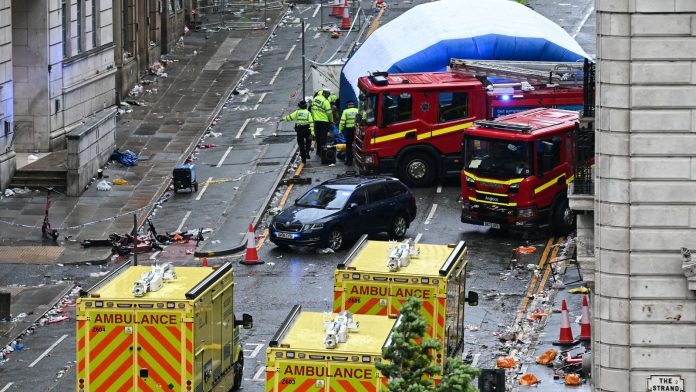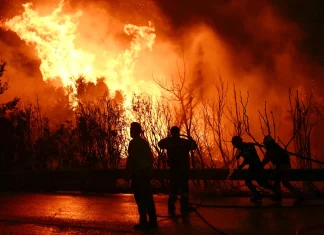Tragedy Strikes Liverpool Victory Parade: The Heartbreaking Story Behind the Charges
On a warm spring evening in late May, something unthinkable shattered the jubilant celebrations in Liverpool. The city was alive with the exuberance of fans who had just witnessed their beloved football team clinch the Premier League title—a historic moment, a dream realized after decades of heartbreak and hope. Streets thronged with joy, laughter, and the echo of cheers filled the air.
But amidst the celebration on Water Street, a wave of jubilation turned into shock and horror. A vehicle—a Ford Galaxy Titanium—was driven into clusters of people, cutting through the crowd like a blade. The joyous evening became one of distress and disbelief. This is the story behind those headlines; a story that’s raw, multi-faceted, and deeply human.
Paul Doyle: A Man at the Center of a City’s Nightmare
Paul Doyle, 53, a resident of Croxteth, Liverpool, appeared via videolink in Liverpool Crown Court. We witnessed a man burdened with the gravity of the moment—his attempt to speak was interrupted by tears, as he confirmed his name before the judge. He seemed overwhelmed—not the stoic figure many accused in courtrooms often project, but a man visibly cracking under the emotional weight of what has unfolded.
Initially charged with seven offences related to the incident, Doyle now faces an additional 24 charges. The alarming expansion of accusations reflects the magnitude of the tragedy: authorities say the victim count stands at 29 individuals, ranging in age from a mere six months to 77 years old. Among the most heartrending details? Two of the alleged victims are babies, just six and seven months old at the time of the crash.
Merseyside Police reported that a staggering 134 people were injured in the chaos that followed the vehicle’s entry into the crowd. Imagine for a moment: the community that gathered to celebrate, united by their passion for football, instantly plunged into confusion and fear.
The Charges: A Portrait of Pain and Legal Complexity
The charges against Doyle, now numbering 31 counts, paint a sobering picture. They include:
- 18 counts of attempting to cause grievous bodily harm
- 9 counts of causing grievous bodily harm with intent
- 2 counts of wounding with intent
- 1 count of dangerous driving
- 1 count of affray
What do these legal terms mean to the layperson? “Grievous bodily harm” refers to serious physical injury or harm inflicted on individuals, signaling the extreme risk and suffering experienced by those caught in the incident. “Affray” involves fighting in public places that causes others to fear for their safety. Dangerous driving, obviously, points to reckless behavior behind the wheel that inflicted these injuries.
At the heart of this legal crucible are the victims—men, women, children, and sadly, infants. It’s a stark reminder that when violence descends into a public celebration, the ripple effects reach far beyond those initially caught up in the event.
A City’s Response: Resilience Amid Sorrow
For Liverpool, this incident is not just another news story. It is a wound that has pierced the soul of the community. The city is renowned worldwide not only for its football legacy but for its warmth, resilience, and community spirit—a spirit fiercely embodied during moments of hardship.
Local resident and longtime fan, Mary O’Connor, shared her mixed emotions: “It was supposed to be our day of joy. We gathered not just to celebrate football but to be together, to feel proud. Now, every time I pass Water Street, I’m reminded that joy can be so fragile.”
At the same time, the waves of support for those injured have been overwhelming. Volunteer groups, local health services, and charities mobilized quickly to provide aid. Jurgen Klein, a trauma expert at a Liverpool hospital, remarked, “We’re not only treating physical wounds but beginning to address the psychological trauma affecting people of all ages—especially children.”
This tragedy unfolds against a global backdrop where public safety at large gatherings is increasingly scrutinized. Questions arise: How can cities safeguard their celebratory moments? What protocols need reevaluation? And how do communities mend after traumatic collective experiences?
Looking Ahead: Seeking Justice and Healing
Paul Doyle’s case is due to return to court on 4 September, when he is expected to enter pleas. The hearing is anticipated to stretch over several weeks, with a trial provisionally set for late November.
Legal experts observe that this will be a complex case, requiring detailed examination of Doyle’s intent and circumstances. Emily Harding, a criminal law specialist, explained, “Cases with multiple victims and such serious charges often become lengthy proceedings. The court’s priority is ensuring justice is served while respecting due process.”
For those who suffered wounds—physical or emotional—the road to recovery will be long. But Liverpool’s collective heart beats with resilience. Football legend Ian Rush, himself a symbol of the city’s fighting spirit, summed it up poignantly: “We are a city that stands together. From tragedy, we find strength. And from pain, we rebuild.”
Reflecting on the Fragility of Joy and the Strength of Community
As readers around the world, what can this story teach us? Perhaps it’s a reminder that amidst our finest celebrations, we are still vulnerable. That joy, like glass, can be broken—but it can also be pieced back together if we embrace empathy, courage, and solidarity.
If you’ve ever been part of a large gathering—a festival, parade, or protest—you might recognize the thrill of collective euphoria. But also consider the unseen risks and the profound need for vigilance and care.
In Liverpool’s May night tragedy, the city’s people face a sprawling challenge: to remember those hurt, to hold their community close, and to look beyond the immediate heartbreak toward healing and hope.
What do you think a city’s response to trauma reveals about its character? How do you believe we can balance celebrating life’s wonders while protecting those who share in its moments? The conversation is ongoing, and the questions, deeply human.










